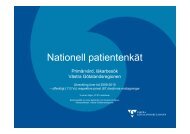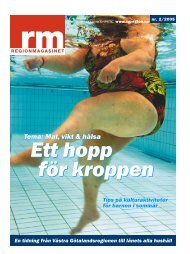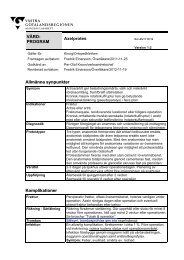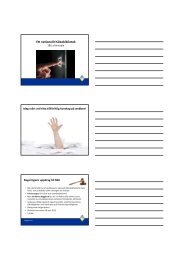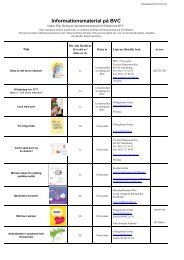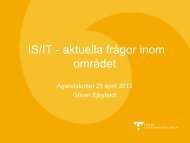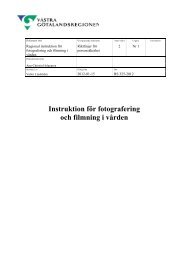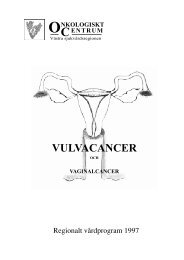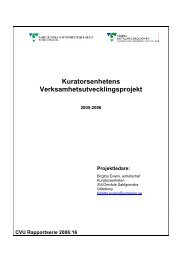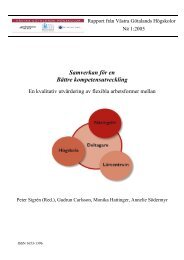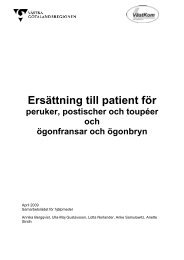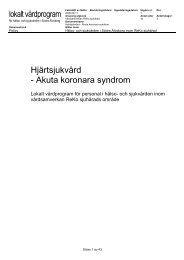FOURTEENTH ANNUAL EUROPEAN PRESSURE ULCER ...
FOURTEENTH ANNUAL EUROPEAN PRESSURE ULCER ...
FOURTEENTH ANNUAL EUROPEAN PRESSURE ULCER ...
Create successful ePaper yourself
Turn your PDF publications into a flip-book with our unique Google optimized e-Paper software.
Thursday September 1st<br />
Proceedings of the 14th Annual European Pressure Ulcer Meeting<br />
Oporto, Portugal<br />
The first national pressure ulcer prevalence study in Sweden<br />
Ami Hommel 1* , Carina Bååth 2 , Ewa Idvall 3 , Lena Gunningberg 4<br />
1* Lund University & Skåne University Hospital, Sweden, Ami.Hommel@med.lu.se<br />
2 Karlstad University & County Council of Värmland, Sweden 3 Malmö University & Skåne University Hospital, Sweden<br />
4 Uppsala University & Uppsala University Hopital, Sweden<br />
Introduction<br />
Two hospitals in Sweden conducted in 2002 the first<br />
pressure ulcer prevalence study, using the<br />
methodology developed by the European Pressure<br />
Ulcer Advisory Panel (1). The methodology has spread<br />
to many hospitals and nursing homes and shows<br />
prevalence that vary between 19-27% when pressure<br />
ulcer category 1 is included (2,3). But there has also<br />
been quality improvement work using different<br />
methodologies, which make it difficult to compare<br />
outcomes. In Sweden there are about 100 quality<br />
registries and public comparison is available between<br />
the 21 county councils and regions. These quality<br />
registries have focused on medical diagnosis and few<br />
include nursing sensitive quality measures. The<br />
Swedish Associations of Local Authorities and<br />
Regions (SALAR) launched a patient safety initiative in<br />
2007. One out of six areas that were prioritized was<br />
pressure ulcers.<br />
The aim of this study was to describe pressure ulcer<br />
prevalence and prevention in hospitals and nursing<br />
homes on a national level.<br />
Methods<br />
The study used a cross sectional design and all<br />
Swedish hospitals (n=84) and nursing homes (2100)<br />
were invited to participate. The hospitals and nursing<br />
homes decided if and how many wards they were able<br />
to include. All patients 18 year and above were<br />
applicable to the study. The study was conducted<br />
during one specific day in March 2011<br />
An expert group was formed by the SALAR. This<br />
group developed the data collection protocol and<br />
instructions for the site coordinators.<br />
Educational sessions (n=10) were conducted in<br />
different parts of Sweden, including possibility to<br />
participate on-line. The PUCLAS educational program<br />
was recommended for all data collectors.<br />
Instructions, protocols, information letter to the patients<br />
were available on the SALAR web site. The<br />
methodology followed the EPUAP recommendations<br />
(1). In addition, information to identify hospital acquired<br />
pressure ulcers were gathered from the patient<br />
records (4)<br />
93<br />
Results<br />
Totally 37 113 patients were included in the study,<br />
17353 from hospitals and 18 865 from nursing homes.<br />
All 7 university hospital participated.<br />
The results will be published online in May 2011, and<br />
then prepared for this report.<br />
Discussion<br />
The Swedish government and the SALAR have an<br />
agreement to improve patient safety during year 2011<br />
to 2014. The agreement includes all heath care funded<br />
by the county councils and has a performance-based<br />
remuneration model to the county councils. When<br />
more than 50% of a hospital’s wards participated this<br />
generated money to the county council. Totally 100<br />
million Swedish crowns were allocated. This might<br />
have been a reason why so many hospitals<br />
participated in the study. However, many municipals<br />
participated as well without any extra money.<br />
Clinical relevance<br />
This study highlights the importance of nursing<br />
sensitive outcomes in quality improvement work on a<br />
national level.<br />
Acknowledgements<br />
We appreciate the support of the Swedish<br />
Associations of Local Authorities and Regions.<br />
Conflict of Interest<br />
None<br />
References<br />
[1] Vanderwee K, Clark M, Dealey C, Gunningberg L,<br />
Defloor T. Pressure ulcer prevalence in Europe: a pilot<br />
study. J Eval Clin Pract, 2007;13(2):227-35.<br />
[2] Gunningberg L, Brudin L, Idvall E. Nurse Managers’<br />
prerequisite for nursing development: a survey on<br />
pressure ulcers and contextual factors in hospital<br />
organizations. J Nurs Manag 2010:18:757-766.<br />
[3] Wann-Hansson C, Hagell P, Willman A. Risk<br />
factors and prevention among patients with hospitalacquired<br />
and pre-existing pressure ulcers in an acute<br />
care hospital. J Clin Nurs 2008;17:1718-27.<br />
[4] Aydin C, et al. Creating and analyzing a statewide<br />
nursing quality measurement database. J Nurs<br />
scholarsh 2004;36:371-378.<br />
Copyright © 2011 by EPUAP



